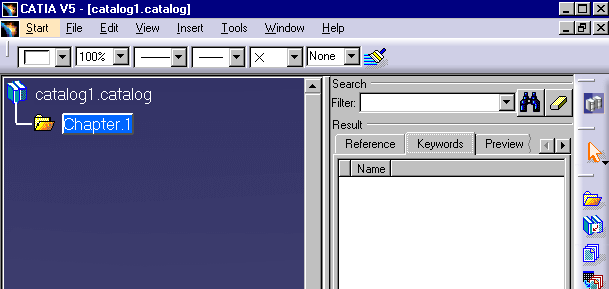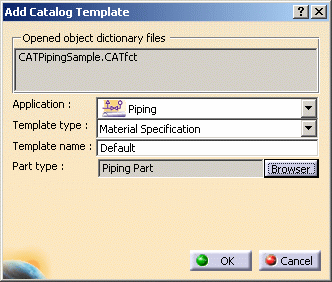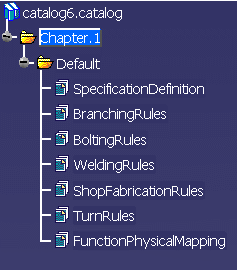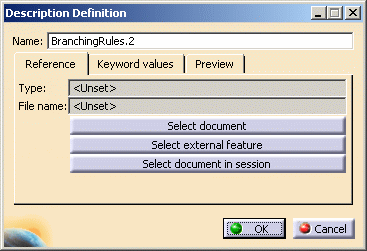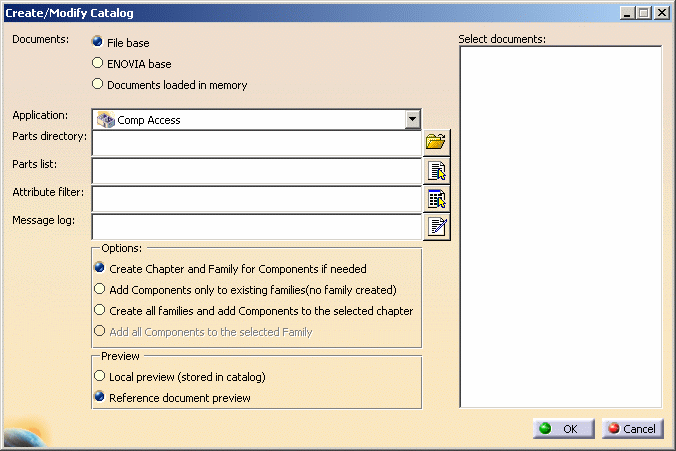Creating a Specifications Catalog
|
|
This task shows you how to create a specifications catalog.An example from the Piping workbench is used here. The process for other workbenches is the same - simply use the relevant CATfct file and terminology. For instance, in the Tubing workbench you would use Tubing Part instead of Piping Part. See also Creating a Specifications Catalog in the ENOVIA section. | |
|
|
A
manual procedure for creating a
specifications catalog also exists, but it is recommended that you use
the procedure described here. However, you should not mix the two. Do
not use the manual process to modify a specifications catalog created
using the automated process (which uses the Create/Modify Catalog
command described below). And vice versa. The sample specifications
catalog included with this application was created using the manual
procedure. You should take note of an important difference between the two procedures: a specifications catalog that is created with the Create/Modify Catalog command described here points to individual parts. Therefore parts from more than one master catalog can be included. A specifications catalog that is created with the manual procedure points to a master catalog - therefore only parts from one catalog can be included in it. A specifications catalog allows you to specify which parts can be used for a certain project or part of a project. The parts or the main catalog typically contains all the parts available to you. However, in many circumstances you will only want to use parts that have certain properties - if you are building a system for conveying hot gases under pressure, for instance, you will only want to use pipes and parts that have a certain heat tolerance, are made of certain materials and have a certain pressure rating. You achieve this by specifying in the specifications catalog what the properties should be for the parts you want to use. The specifications catalog will not contain copies of the parts, but when you place parts using it, you will only be able to use parts from the main catalog that meet the criteria you have specified in that specifications catalog. The specifications catalog provides another important function - it can generate new parts for a project without increasing the number of parts in the main catalog. This is done because the specifications catalog can apply a value to an attribute on a part in the main catalog. This attribute is referred to as generic attribute. This can significantly reduce the number of parts you have in your main catalog. The way it works is like this: say you have four projects in your company that use pipe made of four different materials. You do not have to create four main catalogs, or add four pipes to one catalog, each with a different material defined. Instead what you can do is add one pipe to your main catalog with the attribute 'materialcode' (or any term you choose) but with no value defined for this attribute. Now, when you create the attribute filter file (explained in Step 9 below) you list the material you want for a particular project and put an asterisk after it. The material you have listed will be defined for the property materialcode. All you have to do is make four specifications with the four different materials you need. In addition to specifying the properties of parts, you also have to associate rules tables. This application incorporates intelligent design functions. This means that as you design, the application ensures your designing meets certain criteria. These criteria are established by the design rules. For instance, the design rules will match the threaded end of a pipe to the threaded end of a part. (You can override the rules if you want.) When you use the provided template to create a specifications catalog you can modify the design rules (see Modifying Design Rules) but you cannot add new rules. |
|
|
|
1. | Click Start - Infrastructure - Catalog
Editor to start the Catalog Editor.
|
| 2. | Open the CATfct file associated with your
application. To do this, click the Open User Dictionary button
|
|
|
|
You can add default rules to your specifications catalog (explained below). These rules appear in a separate chapter named "Default". The rules in the Default chapter will apply to all specifications that you create - if they are not defined in that specification. When you are placing a part using a particular specification, the application first determines if relevant rules are defined under that specification. If they are defined then it will use those rules. If they are not defined then it will use the rule under the Default specification. This saves you having to associate rules for each specification that you create. | |
| 3. | Click the Add Catalog Template
button
|
|
| 4. | Select the application (Piping),
and then click on the down arrow in the Template Type field and make your
selection - in this case Material Specification. Enter a name for the
specifications catalog in the Template Name field. If you are creating
default rules you must enter the name Default. Click on the Browser
button next to the Part Type field and make your selection. In this case it
is Piping Part because this is a Piping specifications catalog. Click OK.
The Default chapter and the default design rules display in the
specifications tree.
In applications where you can create both a material specifications catalog and insulation specifications catalog, there may be differences in the design rules that appear in each type of catalog. |
|
| 5. | You now need
to associate the actual design rules table (which is how design rules are
defined) to each of the design rules in the specifications tree. Double
click on a rule and then click the Add Component button
|
|
| 6. | Click the Select Document
button. In the File Selection box that displays navigate to the directory
where the design rules tables are. They are CATProduct type files. (From
Release 13 you can link directly to the text tables that define each rule.)
The default directory is intel_a\startup\EquipmentandSystems\XXX\Specification
(where XXX is your application) and then the specification itself, say
Cs150r. Open the Cs150r directory and select the text file (or table) that
corresponds to the rule that you double-clicked, in this case
BranchingRules. Click Open on the File Selection box and OK on the
Description Definition box. The table will be associated with the rule and
display in the Catalog Editor.
If you click on the Reference tab you will be able to see the full directory path. NOTE: If you are working in the ENOVIA database then you cannot link directly to a text file as explained above. Instead you must link to the CATProduct containing the design rule. In addition, the text file must be stored within the CATProduct (using the Duplicate in CATIA option). The text file and the CATProduct should not have the same name. |
|
| 7. | Associate all the rules with the corresponding tables using the procedure described above. | |
|
|
There is a slightly different process for associating the FunctionalPhysicalMapping tables. If you associate to the CATProduct then you need to associate with one file. If you associate with the text files then you will need to associate with one text file for each function, following the process given above. (From Release 13 the sample catalog points to text files.) Also, in the Description Definition dialog box you should make sure to enter the actual function name in the Name field. For instance, if you are associating the text table XXX_FunctionPhysical-Branch.txt, the function name for it is XXXBranchFunc, where XXX is the application, such as Piping. | |
| 8. |
After you
have associated the rules you can create one or more specifications. To do
this, select the root chapter and click the Add Chapter button
|
|
| 9. | You need to take a couple of
preparatory steps before you begin the process of creating a specifications
catalog.
The first line contains the properties, or keywords. You can add any property that is defined for a part. You can add "Min" or "Max" before a property to identify the minimum or maximum value the catalog should point to. If a part has a property value outside this range it will not be included. Adding an asterisk in the column heading makes the property generic, causing the value of the attribute to be used to create new parts during parts placement. These parts are specific to the project and do not increase the number of parts in the main catalog. If you add an asterisk (*) after a property (in the column heading) then the value of that property in the part will be replaced by the value you enter in this file. You can also add the asterisk after a particular value. The value has to be 'character type' - not a figure. So, if you place an asterisk in the column heading then this behavior will apply to all parts. If you place it against a particular value, then it will only apply to that particular part. The usage is explained at the beginning of this task. NamingRuleKW: In this column, enter keywords separated by commas. These keywords determine the part naming convention, as explained below. Having this column, or defining a keyword, is optional. If you do not have this column, or have it but do not define a keyword, then the part will be named using the default behavior below.
You can give the file any name. However, this file name must be used in the Attribute Filter field of the Create/Modify Catalog dialog box. The Create/Modify Catalog command uses this file to select only the parts that meet the filter criteria defined in it. |
|
|
|
The value of a part
attribute must be unset before it can be a generic attribute in the
catalog. A family/chapter created using the command Add Spec Family cannot be used by the Create/Modify Catalog command. Delete the family and recreate it using the Add Application Chapter/Family command, or let the Create/Modify Catalog command create the necessary families. |
|
| 10. | Click the Create/Modify
Catalog button
For ENOVIA If your catalog is in the ENOVIA database then you cannot point to a directory. You need to use the following procedure. You may can also use the method for creating specifications catalogs described in the ENOVIA section.
|
|
| 11. | Click OK to create the
catalog. Save it when done. This process can be used for one catalog, or for several sub-catalogs. It is recommended that sub-catalogs be used when the number of parts exceeds 500. |
|
![]()
